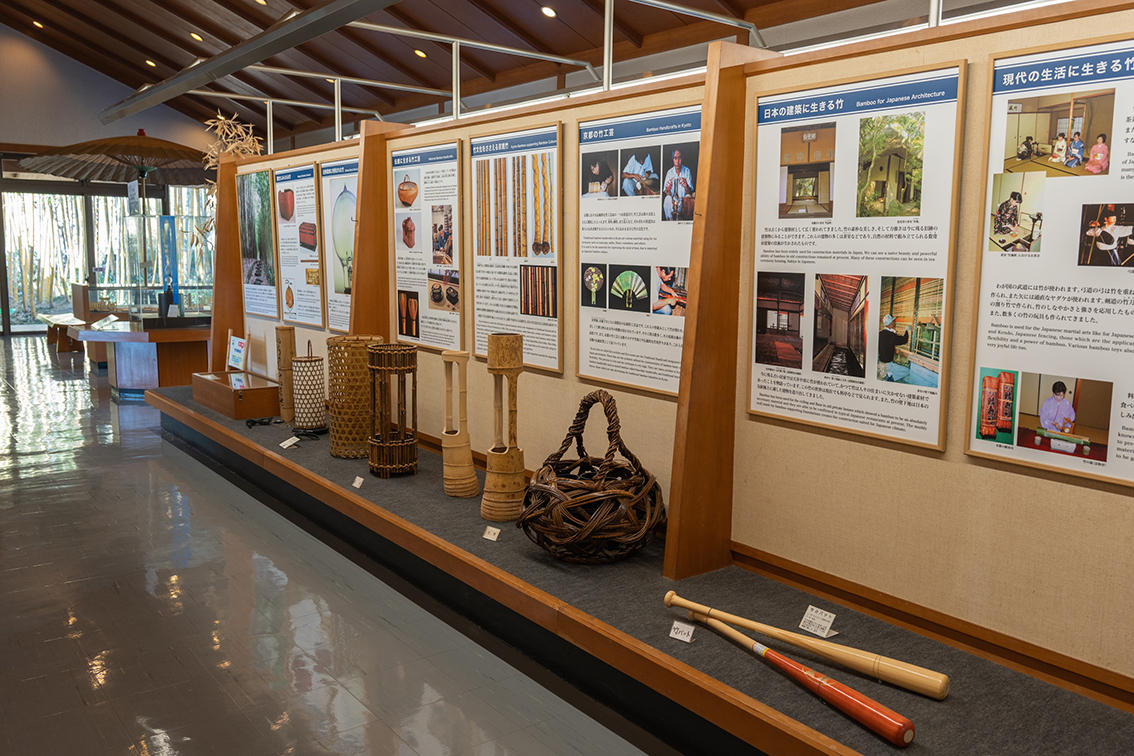In 1981, Kyoto Bamboo Park was established as part of an effort to preserve the city’s bamboo groves that had diminished because of land development. The park’s purpose is to educate visitors about bamboo, its diversity, ecology, and the history of bamboo cultivation in the area. The vast complex contains a museum, a shop with bamboo products and souvenirs, a traditional tea room, a spacious strolling garden with around 110 native and non-native species of bamboo, and a recreation area.
Bamboo Museum
Text panels, photos, and display items cover botanical data, cultivation and harvesting techniques, and the use of bamboo in traditional architecture and crafts. A noteworthy exhibit is a recreation of the bamboo filament lightbulb that the US inventor Thomas Alva Edison (1847–1931) developed and manufactured using bamboo from Kyoto. Many of the panels include English translations.
One wall displays examples of high-quality bamboo produced in Kyoto for construction and decorative purposes. The natural state of each variety can be compared with stalks specially treated to achieve certain coloration or markings, as well as with square-shaped stalks grown by attaching a wooden frame to the young shoot. Kyo-meichiku (“Kyoto bamboo”) is designated one of the Traditional Industries of Kyoto. On the opposite side of the hall are examples of bamboo from other countries.
Across from the reception counter is a small shop with a wide assortment of bamboo items, such as chopsticks, coasters, tea whisks, baskets, toys, artwork, and other souvenirs.
Ecological Garden
The spacious garden with many walking trails contains about 110 varieties of bamboo. Signs provide each species’ common name (in Japanese and romanized script), scientific name, and a brief description in Japanese. Each type of bamboo, whether endemic or imported, is planted in a location that takes topography, sunlight, and other environmental factors into consideration.
The quiet pathways are shaded by towering bamboo, creating a feeling of being one with nature. The appearance of the dense groves changes depending on the bamboo variety, and scenic views open up from various spots on the hillside. The garden is more remote than some other bamboo forests in Kyoto, making it an attractive location for photography. The curving paths conceal what lies beyond each bend, seeming to continue indefinitely through the bamboo.
In the middle of a grass lawn on the northeast side is a weeping cherry tree that blooms light pink in spring. The view of cherry blossoms swaying against verdant bamboo is often regarded as the epitome of springtime in Kyoto. Benches are set up on the lawn for visitors to sit and enjoy the atmosphere of the garden.
Historical Relics
One of the walkways leads to the Dodobashi Bridge, spanning a water-lily pond. Its predecessor was a wooden bridge that stood in the present-day Kamigyo ward of Kyoto. The wooden Dodobashi Bridge is said to have been the site of a fierce battle during the Onin War (1467–1477), which ravaged much of the city. The bridge was remade in stone and later moved to its current location in the park.
Many stone Buddhist statues and other objects are arranged in lines and groups in the garden’s southeast corner. Some of them were originally grave markers, memorial pagodas, foundation stones, and lanterns. However, in 1569 they were used as construction material for the walls of the former Nijo Castle, built for the last Ashikaga shogun, Yoshiaki (1537–1597). Some of the statues and pagodas look mostly intact, while others are significantly damaged or eroded.
Children’s Square
To the southeast of the garden is Children’s Square, a recreation area surrounded by a bamboo grove. It includes spacious lawns, a hillside playground with a slide, and a wading pool. Ramps, multipurpose restrooms, and ample seating make the square a fitting place to spend time with family.
Website: https://chikurin-park.com
Tel: 075-331-3821
Address: Kyoto city, Nishikyo-ku, Ooekitafukunishi-cho, 2 Chome 300-3
Open: 9:00-17:00
Parking: Available
5 min walk from Minamifukunishicho (Chikurinkoen-mae) bus stop

This English-language text was created by the Japan Tourism Agency.

